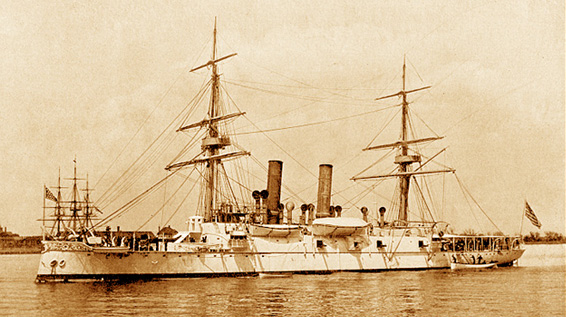|
CG(X)
The CG(X) program, also known as the Next Generation Cruiser program, was a United States Navy research program to develop a replacement vessel for its 22 s. Original plans were for 18–19 ships, based on the 14,500 ton with additional ballistic missile defense and area air defense for a carrier group. These vessels were to enter service beginning in 2017. The program was ended in 2010 with its mission to be fulfilled by the successor to the Flight III ''Arleigh Burke''–class destroyers. History Background In the early 1990s, the U.S. Armed Forces had to respond to new threats and budgets after the end of the Cold War. The U.S. Navy's response was the Surface Combatant for the 21st Century (SC-21) program. This envisaged a destroyer called DD-21 and a planned cruiser called CG-21. Budget cuts in November 2001 meant that SC-21 became the less ambitious Future Surface Combatant program. The DD-21 was renamed DD(X), which was later named the destroyer. By April 2002, DD( ... [...More Info...] [...Related Items...] OR: [Wikipedia] [Google] [Baidu] |
List Of Cruisers Of The United States Navy
This list of cruisers of the United States Navy includes all ships that were ever called "cruiser", either publicly or in internal documentation. The Navy has 17 cruisers in active service, as of 29 September 2022, with the last tentatively scheduled for decommissioning in 2027. With the cancellation of the CG(X) program in 2010, the Navy currently has no cruiser replacement program planned.Defense News The Navy is looking to the -equipped destroyers to increasingly fill the role of the cruiser in the protection of the |
SC21 (United States)
SC-21 (Surface Combatant for the 21st century) was a research and development program started in 1994 intended to design land attack ships for the United States Navy. A wide variety of designs were created and extensively examined, including an arsenal ship with 500 cruise missiles. Eventually a "tumblehome" design of around 16,000 tons with two long-range guns and 128 missile tubes was selected as the DD-21, the Destroyer for the 21st century. The program ended in November 2001. Background The origins of SC-21 lie in the realization by Admiral Joseph Metcalf III that new technologies such as vertical launch missiles permitted a complete rethink of warship design. He established a steering group, Group Mike, to study the possibilities. Group Mike sponsored two studies in 1987: the Ship Operational Characteristics Study (SOCS) and the Surface Combatant Force Requirement Study (SCFRS). Respectively, these studies sought to identify the operational characteristics required of an ... [...More Info...] [...Related Items...] OR: [Wikipedia] [Google] [Baidu] |
AN/SPY-3
The AN/SPY-3 is an active electronically scanned array radar manufactured by Raytheon and designed for both blue-water and littoral operations. Technology X band functionality (8 to 12 GHz frequency range) is optimal for minimizing low-altitude propagation effects, narrow beam width for best tracking accuracy, wide frequency bandwidth for effective target discrimination, and the target illumination for SM-2 and Evolved Sea Sparrow Missiles (ESSM). The X-band has, in general, favorable low-altitude propagation characteristics, which readily support the horizon search functionality of the AN/SPY-3. A large operating bandwidth is required to mitigate large propagation variations due to meteorological conditions. The system uses commercial off the shelf (COTS) computers and has reduced manning requirements for operation and maintenance. A number of operation and maintenance functions can be completely automated. Commercial IBM Regatta series symmetric multiprocessor (SMP) se ... [...More Info...] [...Related Items...] OR: [Wikipedia] [Google] [Baidu] |
Arleigh Burke Class Destroyer
The ''Arleigh Burke'' class of guided-missile destroyers (DDGs) is a United States Navy class of destroyer built around the Aegis Combat System and the SPY-1D multi-function passive electronically scanned array radar. The class is named for Admiral Arleigh Burke, an American destroyer officer in World War II and later Chief of Naval Operations. The lead ship, , was commissioned during Admiral Burke's lifetime. These warships were designed as multi-mission destroyers, able to fulfill the strategic land strike role with Tomahawk missiles; anti-aircraft warfare (AAW) role with powerful Aegis radar and surface-to-air missiles; anti-submarine warfare (ASW) with towed array sonar, anti-submarine rockets, and ASW helicopters; and anti-surface warfare (ASuW) with Harpoon missiles. With upgrades to their AN/SPY-1 phased radar systems and their associated missile payloads as part of the Aegis Ballistic Missile Defense System, the ships of this class have also demonstrated capability ... [...More Info...] [...Related Items...] OR: [Wikipedia] [Google] [Baidu] |
Cruiser
A cruiser is a type of warship. Modern cruisers are generally the largest ships in a fleet after aircraft carriers and amphibious assault ships, and can usually perform several roles. The term "cruiser", which has been in use for several hundred years, has changed its meaning over time. During the Age of Sail, the term ''cruising'' referred to certain kinds of missions—independent scouting, commerce protection, or raiding—fulfilled by frigates or sloops-of-war, which functioned as the ''cruising warships'' of a fleet. In the middle of the 19th century, ''cruiser'' came to be a classification of the ships intended for cruising distant waters, for commerce raiding, and for scouting for the battle fleet. Cruisers came in a wide variety of sizes, from the medium-sized protected cruiser to large armored cruisers that were nearly as big (although not as powerful or as well-armored) as a pre-dreadnought battleship. With the advent of the dreadnought battleship before World W ... [...More Info...] [...Related Items...] OR: [Wikipedia] [Google] [Baidu] |
Cruiser Classes
A cruiser is a type of warship. Modern cruisers are generally the largest ships in a fleet after aircraft carriers and amphibious assault ships, and can usually perform several roles. The term "cruiser", which has been in use for several hundred years, has changed its meaning over time. During the Age of Sail, the term ''cruising'' referred to certain kinds of missions—independent scouting, commerce protection, or raiding—fulfilled by frigates or sloops-of-war, which functioned as the ''cruising warships'' of a fleet. In the middle of the 19th century, ''cruiser'' came to be a classification of the ships intended for cruising distant waters, for commerce raiding, and for scouting for the battle fleet. Cruisers came in a wide variety of sizes, from the medium-sized protected cruiser to large armored cruisers that were nearly as big (although not as powerful or as well-armored) as a pre-dreadnought battleship. With the advent of the dreadnought battleship before World W ... [...More Info...] [...Related Items...] OR: [Wikipedia] [Google] [Baidu] |
SM-3
The RIM-161 Standard Missile 3 (SM-3) is a ship-based surface-to-air missile system used by the United States Navy to intercept short- and intermediate-range ballistic missiles as a part of Aegis Ballistic Missile Defense System. Although primarily designed as an anti-ballistic missile, the SM-3 has also been employed in an anti-satellite capacity against a satellite at the lower end of low Earth orbit.Pentagon news briefing of February 14, 2008video : although no name for the satellite is given, the launch date of December 14, 2006 is stated The SM-3 is primarily used and tested by the and also operated by the |
Kinetic Energy Interceptor
The Kinetic Energy Interceptor (KEI) was a planned U.S. missile defense program whose goal was to design, develop, and deploy kinetic energy-based, mobile, ground and sea-launched missiles that could intercept and destroy enemy ballistic missiles during their boost, ascent and midcourse phases of flight. The KEI consisted of the Interceptor Component (kinetic projectile), the Mobile Launcher Component, and the Command, Control, Battle Management, and Communications (C2BMC) component. On 7 May 2009, the KEI program was canceled due primarily to financial reasons. First stage rocket motor tests There were five first-stage rocket motor tests planned to be carried out by Alliant Techsystems (ATK) in Promontory, Utah. The second test firing of a KEI first stage rocket motor was conducted on 14 June 2007. The static firing included a full duration burn and a demonstration of the thrust vector control nozzle. The fourth test firing of the first-stage rocket motor was completed on No ... [...More Info...] [...Related Items...] OR: [Wikipedia] [Google] [Baidu] |
DF-21
The Dong-Feng 21 (DF-21; NATO reporting name CSS-5 - Dong-Feng () is a two-stage, solid-fuel rocket, single-warhead medium-range ballistic missile (MRBM) in the Dong Feng series developed by China Changfeng Mechanics and Electronics Technology Academy. Development started in the late 1960s and was completed around 1985–86, but it was not deployed until 1991. It was developed from the submarine-launched JL-1 missile, and is China's first solid-fuel land-based missile. The U.S. Department of Defense in 2008 estimated that China had 60-80 missiles and 60 launchers; approximately 10-11 missiles can be built annually. Originally developed as a strategic weapon, the DF-21's later variants were designed for both nuclear and conventional missions. It is thought able to carry a high explosive, submunition, or 300 kt nuclear warhead. The latest DF-21D was said to be the world's first anti-ship ballistic missile (ASBM). The DF-21 has also been developed into a space-capable anti-sate ... [...More Info...] [...Related Items...] OR: [Wikipedia] [Google] [Baidu] |
China
China, officially the People's Republic of China (PRC), is a country in East Asia. It is the world's most populous country, with a population exceeding 1.4 billion, slightly ahead of India. China spans the equivalent of five time zones and borders fourteen countries by land, the most of any country in the world, tied with Russia. Covering an area of approximately , it is the world's third largest country by total land area. The country consists of 22 provinces, five autonomous regions, four municipalities, and two Special Administrative Regions (Hong Kong and Macau). The national capital is Beijing, and the most populous city and financial center is Shanghai. Modern Chinese trace their origins to a cradle of civilization in the fertile basin of the Yellow River in the North China Plain. The semi-legendary Xia dynasty in the 21st century BCE and the well-attested Shang and Zhou dynasties developed a bureaucratic political system to serve hereditary monarchies, or dyna ... [...More Info...] [...Related Items...] OR: [Wikipedia] [Google] [Baidu] |
Aegis Ballistic Missile Defense System
The Aegis Ballistic Missile Defense System (Aegis BMD or ABMD), also known as ''Sea-Based Midcourse'', is a United States Department of Defense Missile Defense Agency program developed to provide missile defense against short to intermediate-range ballistic missiles. The program is part of the United States national missile defense strategy and European NATO missile defence system. Aegis BMD is an expansion of the Aegis Combat System deployed on warships, designed to intercept ballistic missiles in post-boost phase and prior to reentry. Aegis BMD-equipped vessels can engage potential threats using the Standard Missile 3 mid-course interceptors and the Standard Missile 2 and Standard Missile 6 terminal-phase interceptors.Aegis BMD web page , [...More Info...] [...Related Items...] OR: [Wikipedia] [Google] [Baidu] |
AN/SPQ-11
The AN/SPQ-11 Cobra Judy was a PESA radar found on the missile range instrumentation ship. It was used for space tracking, ballistic missiles tracking and other instrumentation. Cobra Judy was the sea component of the COBRA program for monitoring missile launches and outer space. Cobra Judy was replaced by the Cobra Judy Replacement (CJR) in April 2014. Replacement The Cobra Judy Platform, was taken out of service and stricken from the Naval Vessel Register March 31, 2014. On 31 March 2014, the Cobra Judy Replacement program, aboard reached initial operational capability (IOC). According to the Naval Sea Systems Command (NAVSEA), the U.S. Air Force also assumed operational and sustainment responsibilities for the ship. See also * *, platform for Cobra King, the Cobra Judy Replacement * Cobra Dane *Cobra Ball The Boeing RC-135 is a family of large reconnaissance aircraft built by Boeing and modified by a number of companies, including General Dynamics, Lockheed, LT ... [...More Info...] [...Related Items...] OR: [Wikipedia] [Google] [Baidu] |





_SM-3_start.jpg)
